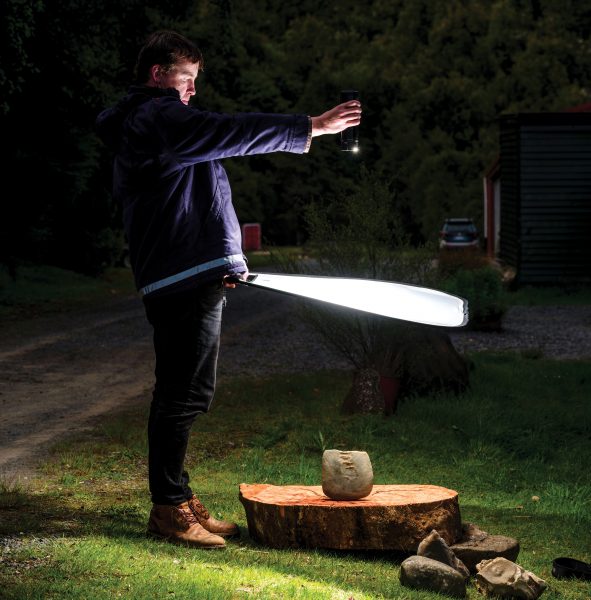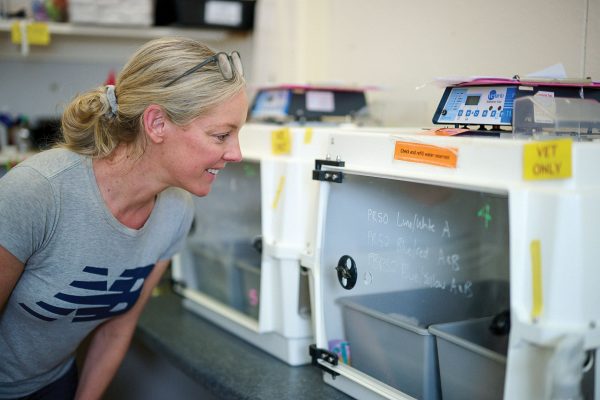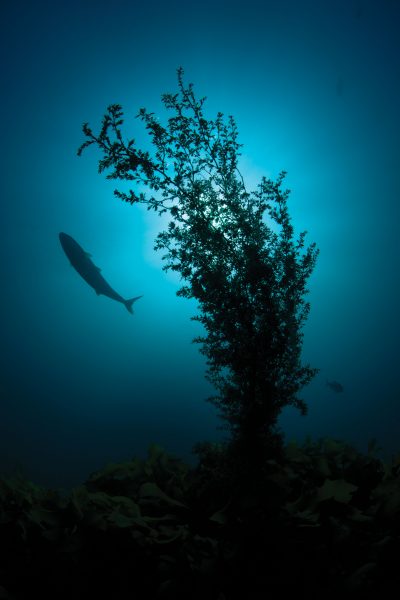Salute
Photographing Endeavour on its recent visit provided moments of magic and fear for Geoff Mason, who has worked on several New Zealand Geographic assignments, including moa, pine and a trek across East Cape. He crossed Cook Strait on the ship to Picton, and then sailed on to Lyttelton. “Welcomes in both harbours were amazing, the sort of thing that the first Whitbread yachts received in Auckland,” he said.
Just as impressive, but in a rather different way, was Endeavour’s passage from Tory Channel into Cook Strait—with Mason perched on the tip of the bowsprit, trying to line up a shot of an interisland ferry following Endeavour. “We went from calm water into a six-metre swell in an instant, and the end of the bowsprit started to hurtle up and down through an arc of about 15 metres. One minute I was in danger of getting catapulted into the sky, and a second or two later I was close to being submerged. Did I risk staying to get my shot, or crawl back?” Needless to say, he stayed, but the photograph proved disappointing. What he did gain was an appreciation of why that position on the ship used to be called “the widow maker.”
Pursuing Endeavour around Fiordland in light aircraft provided excitement, too. “After an evening shoot, our floatplane couldn’t find its way back across the mountains to Te Anau because of cloud and darkness. Fortunately, the red tail light of a helicopter materialised in the nick of time back over a pass. Had it not been for that chopper we would have been in real trouble.”
On board ship, Mason was expected to help with the sailing duties. His least favourite job? Tarring the rigging ropes with a mixture that caused them to stay slippery for a day or two afterwards, increasing the hazards of going aloft. But there were uplifting moments, too. “I’ll never forget coming on deck at 2 A.M. to go on watch as we headed south from Kaikoura, and seeing the brilliance of the stars through the hatch, spangling the rigging. Imagine gazing at those slowly changing patterns of stars for weeks or months on end. Seeing a whale from the top of a mast and being able to holler ‘Thar she blows!’ was pretty special, too.”
Pickersgill Harbour in Dusky Sound, unchanged since the time of Cook—even down to the very tree branch that Resolution is said to have tied up to more than two centuries ago—imparted a unique sense of stepping into history.
So, too, did being ashore with local Maori as Endeavour hove into view at Anaura Bay. “They seemed to be just as flabbergasted at the spectacle as their ancestors were when Cook arrived, and I realised that most of us now in this technological age have no more clues about sailing a ship of that type than the Maoris did then.”
[chapter-break]
Underwater photographers Kim Westerskov and Darryl Torckler have each made a number of visits to Vava’u in their quest for peerless images of humpback whales. On their second visit in the winter of 1994, they an encounter which they count unique in their many and varied experiences with wildlife. Torckler spotted a small spout a kilometre distant, which proved to emanate from a four- or five-metre calf accompanied by its mother. The whales seemed untroubled by the approach of the yacht the two had chartered, and both divers carefully entered the water. After some minutes they were able to pick out the form of the motionless mother about 20 metres below in the clear water. To their astonishment, the baby appeared from beneath the mother and swam directly towards Torckler.
“For a while I photographed its approach, but then, overwhelmed by its closeness, I somehow forgot to keep taking pictures. When it was only a metre away, the whale veered slightly to one side and picked me up on its pectoral fluke and carried me through the water. The calf’s eye, the size of a tennis ball, was scrutinising me thoroughly, and I found this soothing, because although just an infant, the creature was so much bigger than me.
“As I moved away from the whale to try and take some photos, the camera jammed. While I struggled to get it working, the whale swam over to Kim and picked him up in similar fashion on its other pectoral fluke. I watched while he, too, had the ride of a lifetime. Neither of us could believe we’d had such a wonderfully close encounter. Humpbacks are often inquisitive, and may approach you in the water, but usually only for a few seconds before diving steeply away.”
Westerskov’s photograph of the incident appears in the advertisement on page 49.
[chapter-break]
While the waters of Tonga call to whale photographers, it is the beech forests and riverbanks of the Greenstone Valley which draw Tony Maturin. For seven summers, Maturin has served as a but warden of McKellar Hut, on the Greenstone Track, collecting the modest accommodation fees levied by the Department of Conservation, answering trampers’ questions about the track route and the area and being part of the tramper safety radio network.
For five of those years he fished the Greenstone River, regarded as one of the best trout rivers in the South Island, but gave up the sport after deciding that he had “no right to hassle a little animal for my own amusement.”
“Now I fish for pictures,” he says.
“Being able to tell the story of this valley through pictures has given me great satisfaction.”
The former high country musterer and farmer has other stories to tell, too. His book Pilgrimage to Chajul: Tales From Guatemala, documenting the human tragedy of that country, will be published in July.
Death squads and political corruption may seem a far cry from the life cycle of a mayfly or the flowering of a greenhood orchid, but perhaps there similarities. The fragility of human life, the vulnerability of natural habitats—the scales may be different, but both stories need to be told.

















